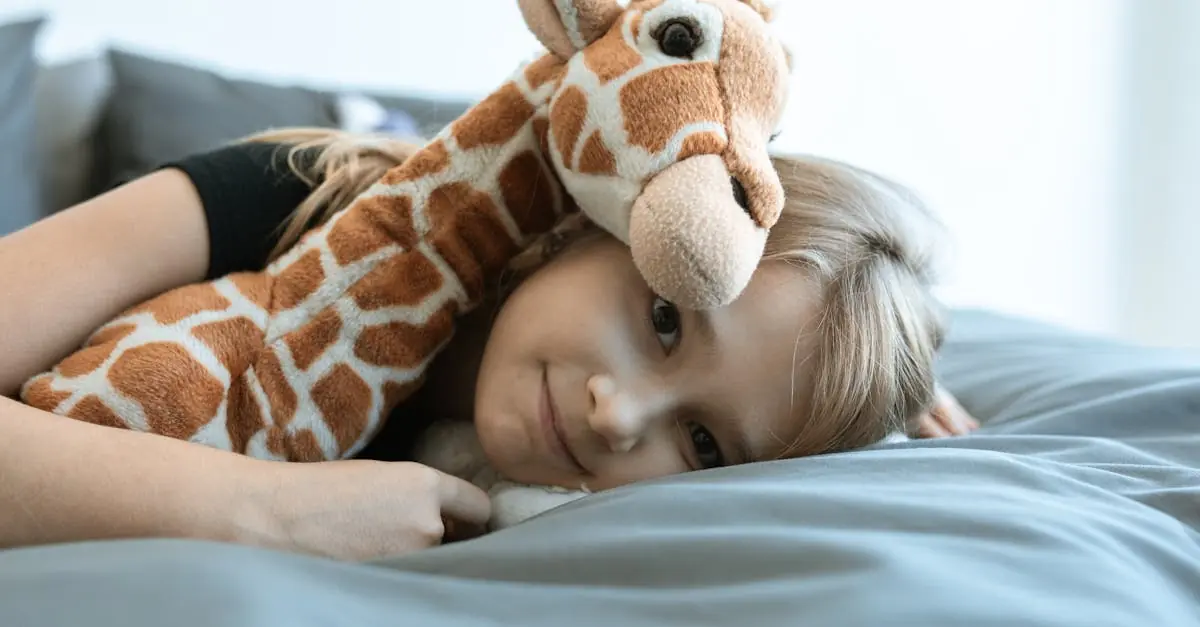When it comes to baby sleep, parents often find themselves in a world of mystery and confusion. Active sleep, a fascinating phase of slumber, is where the magic happens. Imagine your little one twitching, smiling, or even making adorable noises while snoozing away. It’s not just cute; it’s a crucial part of their development.
During active sleep, babies experience vivid dreams and important brain activity, which helps them process the world around them. This stage can leave parents wondering if their baby is awake or just putting on a show. Understanding active sleep can transform sleepless nights into a journey of discovery, making those midnight wake-up calls a little less daunting. Dive in to learn more about this captivating aspect of your baby’s sleep cycle and why it’s essential for their growth.
Table of Contents
ToggleWhat Is Active Sleep In Babies?
Active sleep, known as REM sleep, plays a vital role in a baby’s growth. This stage occurs several times during the night, making up about 50% of their total sleep. During active sleep, babies display various movements. Twitching, smiling, or even whimpering can happen, leading to confusion for parents regarding their child’s state of wakefulness.
Brain activity spikes during this phase, supporting memory consolidation and emotional processing. While resting, babies can process experiences from the day, contributing to developmental milestones. Active sleep allows the brain to strengthen neural connections, which fosters learning.
Importance lies in recognizing these sleep patterns. Parents might notice frequent face movements or irregular breathing, both signs of active sleep. Rather than viewing these occurrences as disturbances, understanding their purpose aids parental insight.
Nighttime awakenings could feel challenging. Treating these moments as natural opportunities for engagement encourages a healthier perspective on sleep. Parents should remain attentive but not concerned during active sleep episodes. Providing a calming environment can help infants transition smoothly through their sleep cycles.
Awareness of active sleep enhances the ability to interpret a baby’s needs. Observing and respecting these natural rhythms fosters a trusting bond between parent and child. Understanding active sleep deepens the appreciation for the fascinating complexities of infant development.
Characteristics Of Active Sleep
Active sleep, characterized by distinct behaviors and brain activity, is essential for a baby’s development. Understanding these characteristics clarifies the impact of this sleep phase on growth.
Movements And Reflexes
Movements during active sleep are numerous. Twitching in the arms and legs often occurs during this stage. Infants may also exhibit facial expressions, such as smiling or frowning. Reflexive actions, like grasping, can be seen as they navigate through different sleep cycles. These movements are normal and reflect the brain’s stimulation, reinforcing neural pathways. Parents find comfort knowing these actions indicate healthy brain activity, rather than disturbances.
Brain Activity Patterns
Brain activity during active sleep resembles periods of alertness. Rapid eye movement (REM) is crucial during this time, reflecting heightened brain activity. Sleep cycles alternate between active and quiet sleep, with active sleep making up around 50% of an infant’s total sleep duration. Memory consolidation and emotional processing predominantly occur during this phase. Babies engage in mental processing, integrating experiences from their waking hours. This brain activity supports essential cognitive growth and prepares them for future learning. Understanding these patterns equips parents to appreciate their child’s developmental journey.
Importance Of Active Sleep
Active sleep is essential for a baby’s growth and development. Its significance lies in the various benefits fostered during this critical phase.
Developmental Benefits
Active sleep supports brain development by promoting memory consolidation and emotional processing. This stage accounts for around 50% of a baby’s total sleep, providing ample opportunity for brain activity. During active sleep, neural connections strengthen, which enhances learning capabilities. Twitching, smiling, or other movements during this time indicate healthy brain function rather than interruptions. Parents can recognize these signs as a vital part of their baby’s developmental journey. As babies experience this sleep phase, they equip themselves to absorb new information and process daily experiences effectively.
Impact On Overall Sleep Quality
Active sleep influences overall sleep quality by ensuring a balanced sleep cycle. Alternating with quiet sleep, this phase allows for notable brain activities, similar to periods of wakefulness. Babies with adequate active sleep demonstrate improved regularity in sleep patterns, reducing nighttime awakenings. Understanding this aspect helps parents appreciate the natural rhythms of their child’s sleep. By creating a calming environment, caregivers enhance their baby’s ability to navigate these sleep phases, facilitating deeper rest. Recognizing the interplay between active sleep and overall sleep quality enables parents to support their child’s nighttime experiences better.
How To Recognize Active Sleep In Your Baby
Active sleep can be recognized through specific behaviors and patterns that a baby exhibits during this phase. By observing these cues, parents can better understand their child’s sleep cycles.
Observing Sleep Patterns
Frequent twitching in the limbs often indicates active sleep. Movements such as smiling or fluttering eyelids also occur during this phase. Parents may notice irregular breathing patterns, which don’t signify distress but rather the brain’s heightened activity. Body jerks and facial expressions reflect the various neural processes taking place. Keeping an eye on these patterns helps in distinguishing active sleep from quiet sleep, enhancing understanding of the child’s sleep journey.
Tips For Parents
Maintaining a calm environment is vital during active sleep. Parents should avoid sudden noises that could disrupt this phase. Staying attentive to signs of movement allows for better insight into the baby’s well-being. Engaging with the baby softly can be beneficial, as it encourages a sense of security. Observing the baby’s sleep cycles during routine check-ins helps parents grasp the importance of active sleep in development. Emphasizing gentleness when interacting ensures a balanced experience for the child.
Active sleep plays a crucial role in a baby’s development by fostering essential brain functions. Understanding this sleep phase helps parents appreciate their child’s growth and the natural processes occurring during sleep. Recognizing the signs of active sleep allows for a more informed approach to nighttime routines, minimizing stress and enhancing the parent-child bond.
By creating a calming environment and observing their baby’s behaviors, parents can support healthy sleep patterns. Embracing the complexities of active sleep not only aids in a child’s development but also enriches the parenting experience. This knowledge empowers parents to navigate the challenges of sleep with confidence and care.




